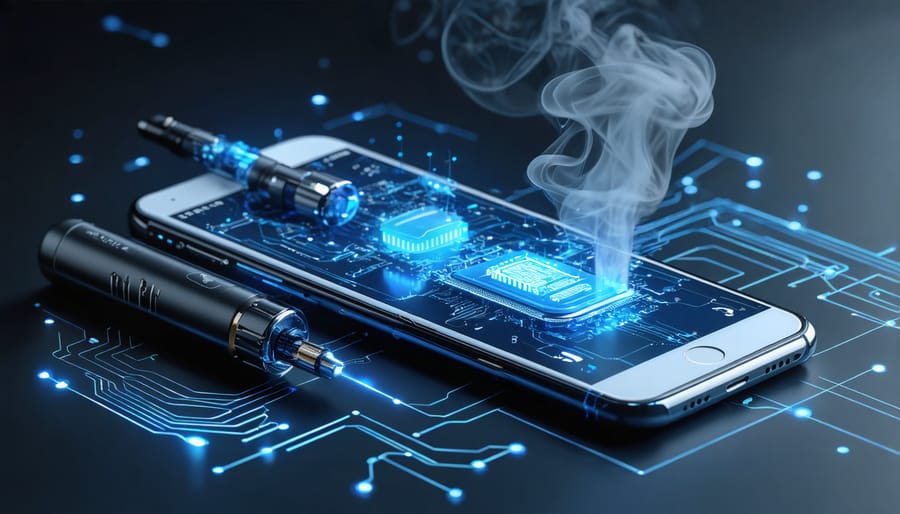Enhance your vaping experience by integrating software to personalize device settings and monitor usage patterns. Optimize device performance by selecting compatible firmware updates that ensure smooth functionality and regular enhancements. Discover the latest advancements in vaping technology, including vape tanks and liquids, to elevate your sessions with cutting-edge designs and flavors. Protect your information with secure apps that offer encrypted data transfer between your vaping device and smartphone. Stay informed about device compatibility and potential security features to maximize safety and user experience.
Understanding Vaping Technology
The Evolution of Vaping Devices
Vaping devices have come a long way since the introduction of basic e-cigarettes, marking a significant shift in both design and technology. The early models, simple and cigalike, prioritized mimicking the look and feel of traditional cigarettes. As technology advanced, so did user expectations, leading to the development of sophisticated gadgets that deliver enhanced experiences. Today, modern vapes boast innovative features like temperature control, customizable power settings, and user-friendly interfaces, making them appealing to tech-savvy users eager for the latest updates.
Software integration plays a pivotal role in this evolution, enabling users to tailor their experiences through mobile apps connected via Bluetooth. Such advancements not only enhance device functionality but also provide practical tips for optimizing usage, like monitoring puff counts and battery life. This progression highlights a keen focus on user personalization and safety, transforming vaping devices into versatile, tech-driven products suitable for both beginners and experienced users. By embracing these technological shifts, vaping continues to redefine itself in the digital age.

Components of Modern Vaping Devices
Modern vaping devices are a blend of sophistication and simplicity, with each component playing a crucial role. At the core is the battery, often rechargeable and providing the power needed to heat the coil. This coil, sometimes referred to as an atomizer, is where the magic happens, heating the e-liquid to produce vapor. The e-liquid is stored in a tank or cartridge, which comes in various sizes and is key to the vaping experience.
Connecting these elements is a chipset, essentially the device’s brain. It regulates power, ensures safety features like temperature control, and sometimes interfaces with software for enhanced customization—a feature of growing importance as technology advances. The mouthpiece, or drip tip, is the final touch, offering a comfortable way to inhale the vapor. Together, these components are tailored to provide both beginners and seasoned tech users with a customizable and controlled experience, demonstrating the seamless integration of technology and user enjoyment in vaping.

Software Integration in Vaping
Smart Features in Vaping Devices
Modern vaping devices have evolved significantly with the integration of software-driven smart features that enhance both user experience and safety. One standout feature is temperature control, allowing users to set their preferred heat level. This not only provides a more consistent vaping experience but also prevents the coil from overheating, which can lead to harmful chemical emissions. Additionally, many devices come equipped with usage tracking features. These advanced tools monitor vape sessions, providing data on puff count and duration. Real-world applications of this include helping users manage their consumption and set personal limits, promoting more mindful vaping habits.
Another exciting development is device customization through mobile apps. These apps allow users to adjust settings, track their usage, and even diagnose device issues remotely, making vaping more interactive and tailored to personal preferences. This combination of technology and personalization in vaping devices empowers users, offering a sophisticated and controlled experience that aligns with the progressive nature of today’s tech-savvy audience.

Mobile Apps and Connectivity
Mobile apps and connectivity have transformed the vaping landscape, offering users innovative ways to personalize and enhance their vaping experience. By integrating mobile technology, vaping devices now allow users to adjust settings such as temperature and power levels directly from their smartphones. This level of customization ensures that users can fine-tune their devices to match their preferences, creating a more enjoyable and personalized vaping journey.
Apps also provide valuable insights into vaping habits, tracking metrics like puff count and battery life. This not only grants users greater control but also aids in understanding usage patterns, which can be particularly helpful for those looking to monitor or reduce their consumption. Additionally, many apps come with features that promote safety, such as software notifications for firmware updates and alerts about potential device issues.
Connectivity extends beyond personalization and monitoring. It includes features like social sharing, where users can connect with fellow enthusiasts to exchange tips and experiences. This community aspect fosters a sense of belonging and encourages discovering new vaping techniques and trends.
In the evolving world of vaping technology, mobile apps and connectivity stand out as essential tools that empower users. By marrying convenience with customization, they not only enhance user satisfaction but also drive the continued innovation and growth of the industry.
Security Concerns in Vaping Technology
Data Security and Privacy
As vaping technology advances with connectivity through apps, data security and privacy become crucial for users. These apps often collect sensitive information ranging from usage patterns to personal data like location. When accessing these apps, ensure they comply with privacy standards. Opt for trusted, reputable brands that prioritize user data protection. For example, check if the app offers encryption and allows for data control settings. Keeping software updated is another simple yet effective way to protect your information. Apps that lack proper security measures can become targets for hackers seeking personal data. Always read privacy policies to understand how your data is used and shared. By being informed, you can enjoy the benefits of vaping technology with greater peace of mind.
Safety Measures and Best Practices
To safeguard against potential security threats in vaping technology, both manufacturers and users should adopt a series of practical safety measures. Manufacturers are encouraged to integrate robust encryption protocols in their devices to protect sensitive data. Additionally, implementing regular firmware updates can help counteract any vulnerabilities discovered post-launch. For users, it is vital to stay informed about updates and apply them promptly to maintain device security.
Moreover, understanding the web development impact on connected devices can illuminate potential weak points. It is also wise to avoid unauthorized third-party apps or modifications, which can introduce security risks. By combining these practices, both tech-savvy enthusiasts and beginners can enjoy a more secure vaping experience, effectively balancing innovation with safety.
The Role of Design in Vaping Tech
User Interface Design
User interface design plays a pivotal role in the usability and satisfaction of vaping software. Well-designed interfaces ensure that users, whether beginners or tech-savvy enthusiasts, navigate through settings and options with ease, enhancing their overall experience. A clear and intuitive design minimizes the learning curve, allowing users to access advanced features without feeling overwhelmed. A good example is how the Django platform has been instrumental in creating user-friendly applications. Similarly, in vaping technology, interfaces that incorporate responsive controls, clear visualization of data, and customizable settings offer a personalized experience. By focusing on simplicity and accessibility, developers can address diverse user needs, ultimately leading to higher satisfaction and greater adoption of modern vaping technologies.
Aesthetic and Functional Innovations
Recent advancements in vaping technology seamlessly blend aesthetics with functionality, creating devices that are not only visually appealing but also highly efficient. Sleek designs featuring customizable LED lights, luxurious metallic finishes, and ergonomic shapes are now common. These enhancements cater to personal style while improving user comfort and experience.
Functionally, smart features are at the forefront. Many modern vape devices now include Bluetooth connectivity, allowing users to control the device via mobile apps. These apps provide real-time data on usage patterns and battery life, giving users greater control and personalization options. Temperature control capabilities, adjustable power settings, and safety features like auto-cutoff are increasingly standard, ensuring a tailored and secure vaping experience. These innovations underscore the industry’s commitment to merging cutting-edge design with intuitive functionality, appealing to both tech novices and seasoned aficionados.
Conclusion
In conclusion, the integration of software with vaping technology is reshaping the landscape of the modern vaping industry. This evolution is not only enhancing the user experience but is also paving the way for more personalized and controlled vaping sessions. With features like customizable settings through smartphone apps and real-time data tracking, users can fine-tune their experience to match their preferences, making the technology accessible and practical for a wide range of users.
Furthermore, the emphasis on security and design shows how manufacturers are prioritizing the safeguarding of personal data while ensuring an attractive, user-friendly product. As we look to the future, the continued development of software integration promises even more sophisticated advancements, such as improved battery management and tailored health recommendations, which will further enrich the vaping experience.
While challenges remain, especially regarding regulatory landscapes and privacy concerns, ongoing innovation in this field holds significant promise. For technology enthusiasts, staying informed about these trends is key to maximizing the benefits of vaping technology and software integration. As these technologies evolve, they will likely offer more exciting possibilities, making it an area to watch for those eager to explore cutting-edge tech solutions.




